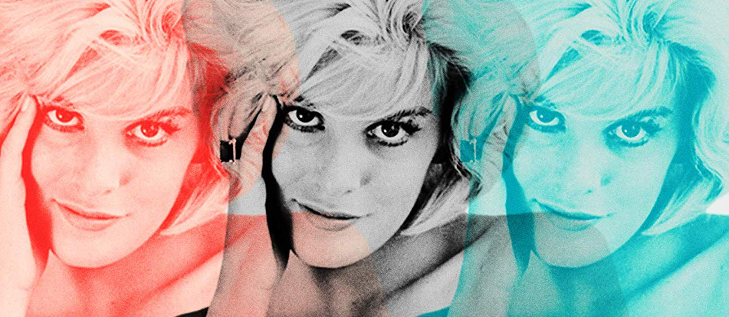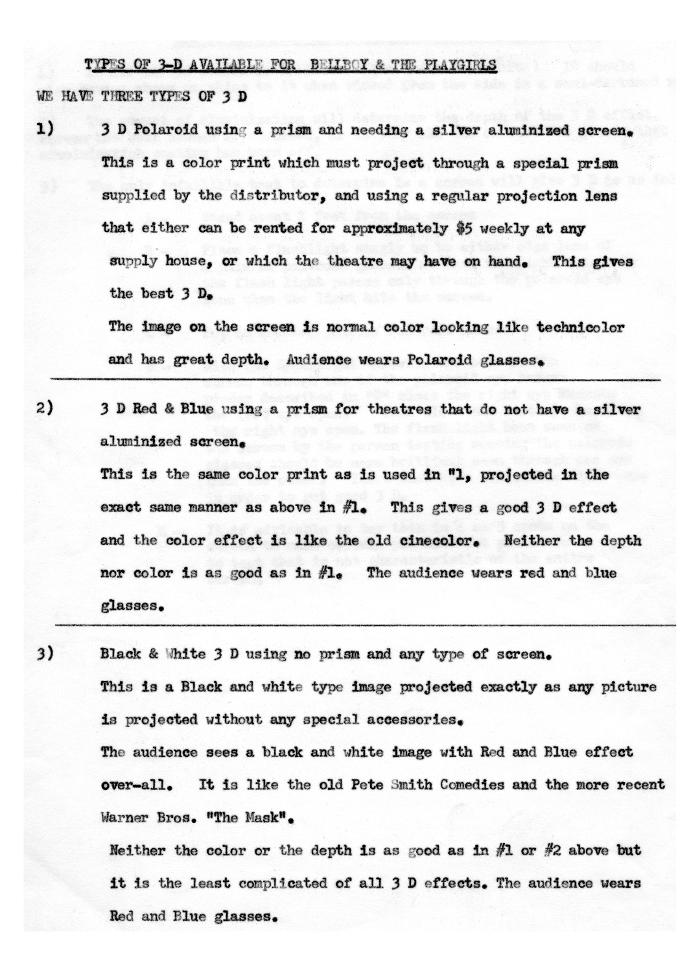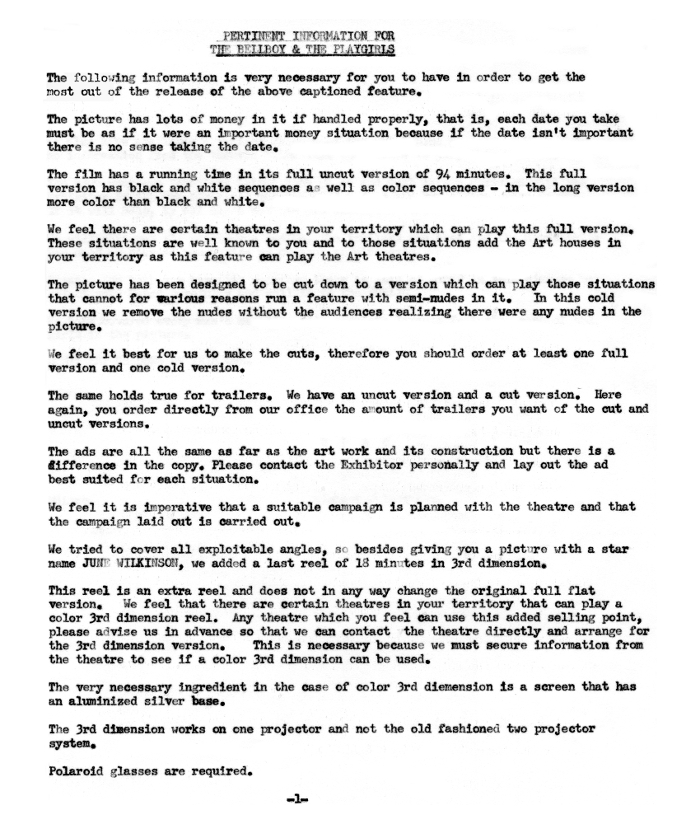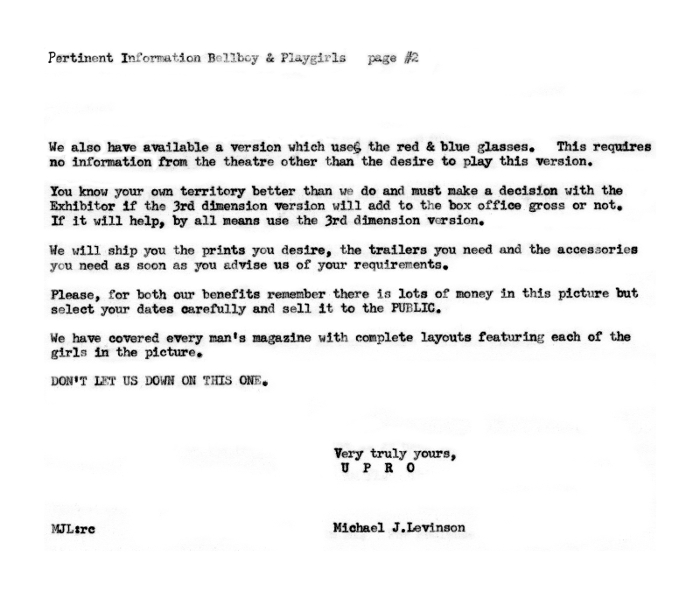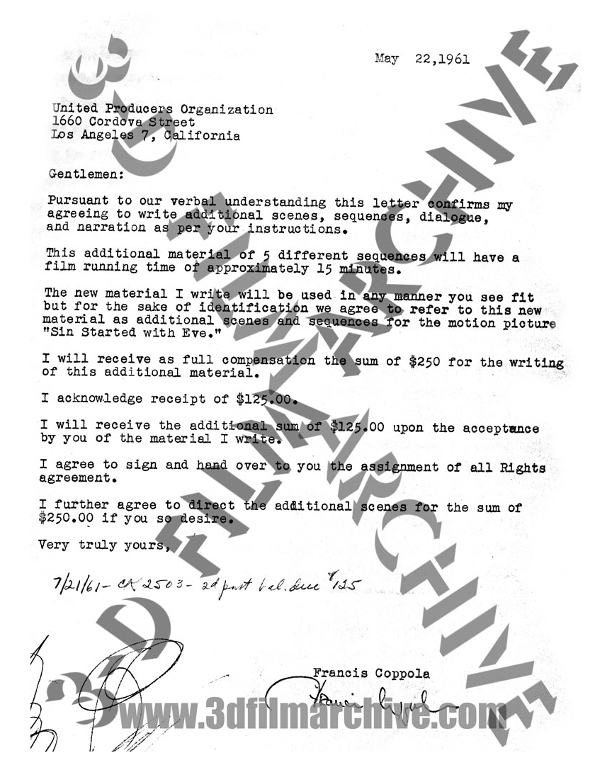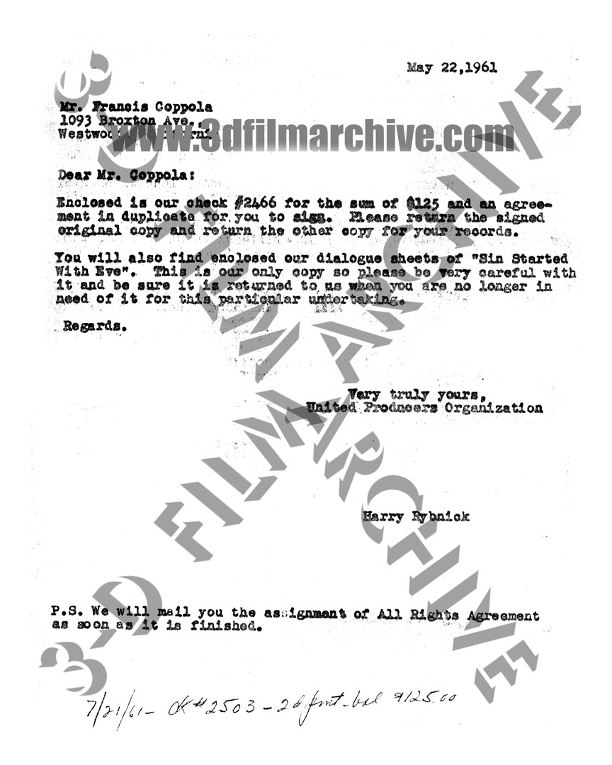The 3-D Nudie-Cuties Collection
Oh, have you reached the right page? We know you were looking for the review of Aunt Minerva’s Hymns of Faith in 3-D. We instead have uncovered a blistering, too-too spicy duo of ‘adult movies,’ created for dirty old men in the prehistoric days before humanity was transformed by X-rated porn. The first show may be the professional screen directing debut of Francis Coppola, moonlighting from UCLA. It’s something of a wreck, but he was not one to miss an opportunity to write and direct. The second picture, in gorgeous color and eye-popping 3-D, is so good as to suggest an art revival, if today’s PC culture wasn’t so likely to condemn a vintage girlie entertainment out of hand. But then again, this sub-genre is supposed to be forbidden and Taboo. Blu-ray 3-D conquers all!

The 3-D Nudie-Cuties Collection
3-D Blu-ray
The Bellboy and the Playgirls; Adam and Six Eves
Kino Classics
1962 / B&W & Color / 1:78 widescreen / 94 + 61 min. / Street Date October 29, 2019 / 34.95
Starring: June Wilkinson, Don Kenney, Karin Dor, Willy Fritsch; Randy Brent, Gabrielle Benett, Marianne Bennett, Shelly Forbes, Leigh Sands, Lorraine Sheldon, Barbara Stanley.
Directed by Francis Ford Coppola; John Wallis
(Don’t Miss an exclusive extra at the bottom of the review.)
Okay, we’ve loved what we’ve so far seen in the Blu-ray revival of vintage 3-D features. One ‘rescued’ depth attraction was The Stewardesses 3-D, a somewhat dispiriting adult film from the early 1970s. For their next safari back into bizarre 3-D history, Kino Classics once again taps the magic technical skills of The 3D Film Archive to investigate the dry, academic realm of a phenomenon known as ‘Nudie-Cuties.’ The 3-D Nudie-Cuties Collection double-bill disc gives us what has been called the best Nudie-Cutie production, Adam and Six Eves, plus an adult film hybrid with a 3-D sequence, The Bellboy and the Playgirls. It would likely have been overlooked were it not one of the first directing efforts of Francis Coppola. Never fear, 3-D challenged mortals: 2-D encodings are included as well.
Back in the 1950s, pioneering publishers and filmmakers succeeded in getting a U.S. high court to rule that nudity per se was not pornography, a decision that led to a proliferation of Nudist Movies. They proclaimed the health and wisdom of nudism, while showing activities in nudist getaways, enhanced, of course with professional body models. Unless history has been rewritten, Russ Meyer’s The Immoral Mr. Teas (1959) launched the Nudie-Cutie trend. Meyer filmed little skits with a photographer buddy playing a fellow who daydreams and hallucinates nude women. The basic idea converts girlie still photos into movie fare — pin-up fantasies that move. Meyer made the whole business look innocent-naughty instead of sordid-slimy. His beautifully-lighted actress-models are sexy, but also funny.
The Nudie-Cutie ‘genre’ only lasted a few years. The old Something Weird video company took possession of several that were abandoned in lab vaults along with hundreds of other vintage adult films. Back in the day, the newspaper listings for these pictures were often segregated from general movie fare, on a page with the burlesque ads. San Bernardino had an off- Main Street theater that played adult fare bypassed by Boxoffice Magazine — Nudie Cuties, ‘rough’ adult dramas, the occasional ‘celebrity’ comedy promising nudity, and really trashy adult films claiming to tell forbidden secrets about Nazi sex crimes. These weren’t art film theaters — to see Cassavetes and Truffaut we’d have to go to Riverside, where there was a UC campus.
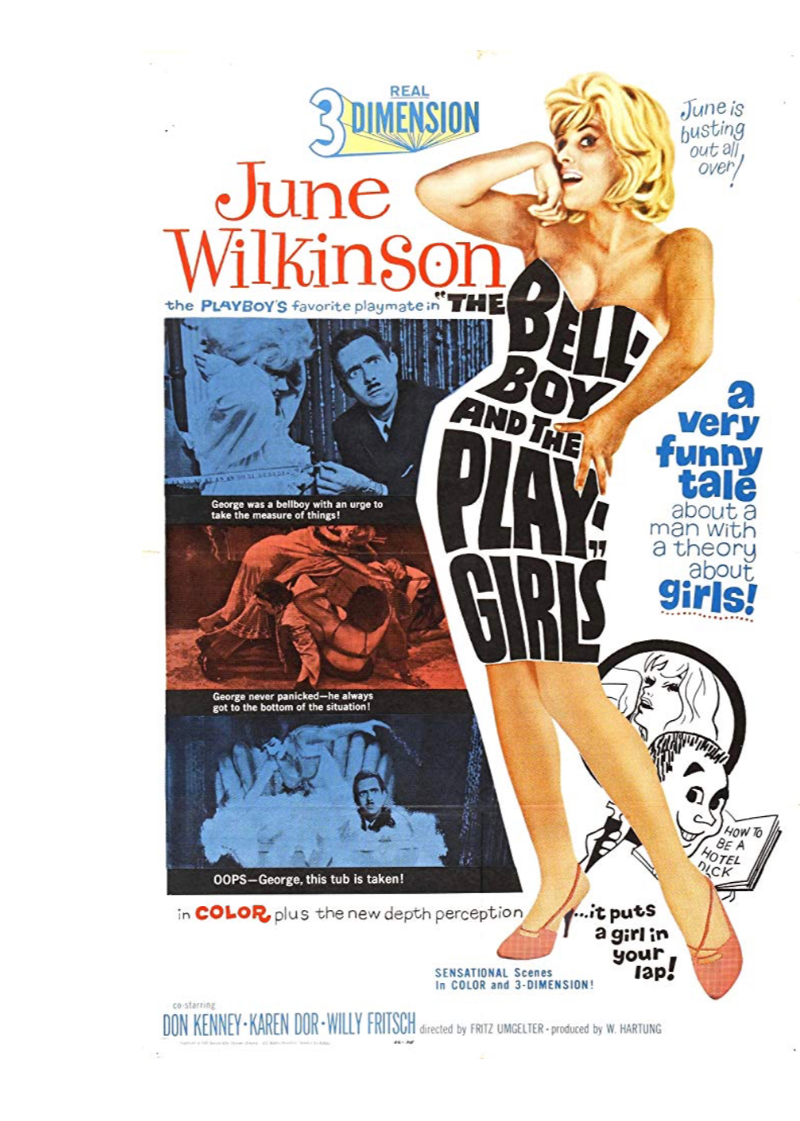
The Bellboy and the Playgirls saw a fairly big release in 1962. It’s not particularly good or funny or sexy but it is of historical interest. Somebody imported what looks to be a fairly tame (and maybe lame) 1958 German comedy about a theatrical troupe trying to enthuse its leading lady in her role as an illicit lover. It looks as though only half of the film remains. The reluctant actress (a young Karin Dor, later well-known from Topaz, The Snake Pit and the Pendulum and You Only Live Twice) is lectured about free sex through history by the director (Willy Fritsch of Fritz Lang’s Spies and Woman in the Moon). The actors take on multiple roles for the fantasy vignettes, none of which seems very funny. A little bit of nudity or near-nudity is present in some of the vignettes.
The movie becomes interesting when we realize that it’s been cannibalized as a comedy foundation for a new story written and directed by Francis Coppola. He filmed maybe thirty new minutes with a comic (Don Kenney) and a score of nude models led by Playboy model June Wilkinson, who is given major promotion in the ad art. Up in the rafters of the (originally German) theater, the stagehand Kenny pulls faces as he explains that he aspires to be the house detective in the hotel where he is presently a bellboy — and to learn about women. That motivates him to find ways to get into room 229, where he thinks Wilkinson is running a prostitution ring. The women are really just modeling lingerie for buyers, and filming a commercial. Coppola cuts back to the German plot line several times, and then abandons it near at the end. Although we see the romantic leads kissing, we don’t know if Karin Dor’s character succumbed and performed a scene nude. We assume not, or Coppola’s producer would have wanted it kept in!

Coppola hews to the rule that Nudie-cutie comedy must remain at the level of comic strip gags. The voiceover is a string of lame jokes. Kenney’s wanna-be house dick is basically a burlesque comic, a sexless clod who never makes contact with the gorgeous showgirls in the skits. I can imagine the raincoat crowd coming to see Bellboy and the Playgirls feeling short-changed. They probably wondered why most of the film is in B&W when it’s advertised in color, as well as when they’d get to use the 3-D glasses they were handed as they entered.
The 3-D and color comes in only for the last reel, when Kenney enters the hotel room dressed in drag. A page in his ‘how to understand women’ book tells us to put on our 3-D glasses. Most of the angles are wide, and anti-cinematic. Coppola was obviously pressed for time and unable to shift the 3-D rig very much. In one static wide shot, the models simply undress, walk away from their makeup table and eventually walk back. It’s all weird, awkward and unnatural. But hey, it’s finally what the poster promises.
Fritz Umgelter’s original direction is smooth and assured, even if the material is a snooze; Coppola’s new patchwork scenes are less polished, but function well. Don Kenney mugs well as the goofus bellboy. Ms. Wilkinson does not disrobe, much to the disappointment of Playboy fans. A big part of the audience surely felt cheated right then and there. The producer must have been happy, for Coppola transformed a mild foreign comedy into a back-alley theatrical performer.
It must have been a leap of faith for the producer to believe that the original movie Mit Eva fin die Sünde an (Sin Began with Eve) could be re-engineered in this way. Of course, re-working parts of one movie into a new plotline is nothing new — the process is even satirized in Singing in the Rain, when Cosmo Brown turns a costume swashbuckler into a dream flashback for a modern musical. They also had the sterling example of the 1956 Godilla, King of the Monsters, which artfully ‘chopped and channelled’ a Japanese original, deftly adding Raymond Burr as a major character.
The fix-up indeed sounds like something Coppola might pitch: the title will remind customers of the hit Jerry Lewis comedy The Bellboy. Coppola had to write new dialogue to fit the German characters’ lip movements, and decide which ones would speak with funny voices, etc.. His cutaways to ‘new’ material often happen right in the middle of the German director’s optical whip pans. All that was needed was one hotel room and corridor set, plus a switchboard desk. For all we know Kenney’s rafter roost might have been filmed in one of UCLA’s student soundstages. We’re told that fellow UCLA student and future director Jack Hill served as Coppola’s cinematographer.
Bellboy and the Playgirls is fascinating when seen as Francis Coppola’s way to get his career in gear, while still in film school. I don’t know when his writing career took off, but he may already have been working for Roger Corman when he signed on for his first Nudie-Cutie movie. Corman and A.I.P. saw profit in buying ‘unplayable’ foreign movies for pennies, and re-editing them into more commercial items; Corman first employed Coppola to editorially re-jigger other foreign films in this way. The one Coppola took credit on was Battle Beyond the Sun, which was made by shearing a Soviet sci-fi drama of its anti-U.S.A. propaganda. These re-write, re-cut and (minimally) re-shoot jobs became proving grounds for more new talent. Corman generated multiple releases from a Yugoslavian murder thriller (giving work to Jack Hill and Stephanie Rothman), and helped set Curtis Harrington up with a space vampire epic cannibalized from another Soviet sci-fi picture. Both Harrington and Corman’s associate Peter Bogdanovich each made a ‘new’ movie from yet another Soviet space film: Voyage to the Prehistoric Planet (1965), and Voyage to the Planet of Prehistoric Women (1968). Was that sort of a ‘graduate project’ for Peter Bogdanovich?

The Bellboy and the Playgirls can boast a bigger recognition factor, but the second 3-D feature Adam and Six Eves is the better film. A cheerful, professionally made core Nudie-Cutie, it delivers exactly what the intended audience has come to see, roughly 55 minutes of non-stop nudity. Like Meyer’s Mr. Teas it’s a burlesque gag stretched to (short) feature length. Hardly anybody in the cast or crew list appears to have other IMDB credits. Were they stage folk enlisted in an adult-film lark, or did they all use noms de nude?
I remember Adam and Six Eves being written up in Playboy (Arthur Knight?) and thinking that the sample photo was just a glossy publicity image. As it turns out THE WHOLE MOVIE looks like a glossy glamour photo shoot, handsomely produced in beautiful, rich color. As the burlesque goofus who comes upon a six pack of gorgeous women in the desert, ‘Randy Brent’ is an ideal Adam — he’s silly but not too infantile. He sports a really sweet smile, too. When leering in delight, Adam makes us think, ‘lucky dog,’ not ‘smarmy creep.’

Prospector Adam walks for a few minutes in an attractive sandy stage set, with his helper Smiley, a donkey. He’s billed as Tobey the Donkey; we don’t know if the donkey was hiding his real name too. Adam promptly stumbles into the fantasy oasis populated by the six Eves. He looks but doesn’t touch, while the Eves smile, make coy faces, parade about, crawl, pose, and dance for the entire balance of the picture. They interfere with his efforts to use a map to find a buried treasure. The only other complication is that one of the Eves is a witchy trickster, with exaggerated eyebrows and a pointy nose; she first appears in snake-like body makeup.
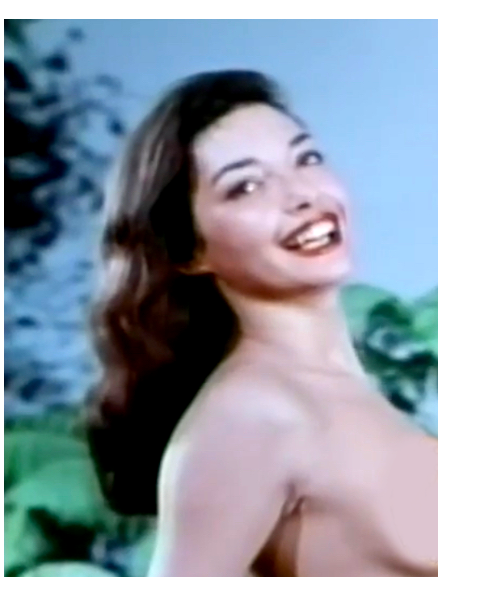
The filmmakers don’t short-change anything — a jaunty music score by Richard LaSalle (The Day Mars Invaded Earth, Twice-Told Tales) is heard throughout. There is no sync dialogue, excepting Adam speaking one word (“Gold!”), so the amusing music is only broken up by narration from Smiley the Donkey. This narration track is very clever, with cute puns and ‘western’ chatter spoken somewhat in the manner of Chill Wills:
“I don’t know who designed her costume, but whoever it was should have been placed in charge of government spending.”
“I wouldn’t exactly call her a gossip, but I noticed that she had her mouth open so much that her tongue was sunburned.”
Adam and Six Eves is as cute and playful as it is, uh, inspirational. The sexy fantasy concept is less problematic than burlesque stories about peeping Toms or sizzle-brained morons experimenting with functioning X-Ray Specs. The silly, cartoonish Adam mostly stays out of the way while the camera gloms the naked women. The actress models put on a smooth act — they seem to like playing happy, seductive phantoms. All are gorgeous, with faces so pretty, they likely did all kinds of commercial modeling. Lonely guys watching this movie must have thought they’d died and gone to heaven.
The few exploitation ‘girlie’ films I have seen all played a bait and switch game. A Nudie-cutie by Herschel Gordon Lewis was ugly and insulting, a rip-off. Even with its Francis Coppola pedigree, The Bellboy and the Playgirls pretty much falls into the category of a carnival come-on to fleece the rubes. But much like Russ Meyer’s playful early features, Adam and Six Eves makes good on its promises.
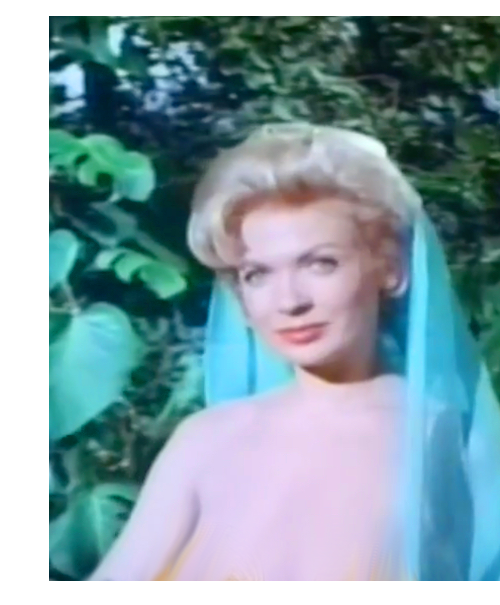
Kino Classics’ 3-D Blu-ray of The 3-D Nudie-Cuties Collection is a great curiosity and quite something for those equipped with Blu-ray 3-D capability. 2-D versions are present as well.
The B&W material in The Bellboy and the Playgirls looks fine. Francis Coppola’s edit job is so slick, it’s possible that many viewers didn’t know that new scenes had been grafted on to an older, foreign movie. Bob Furmanek tells us that although the color / 3-D scenes for Bellboy were scanned from 35mm, they were originally filmed with a Dual-16mm rig. It looks good enough that the smaller gauge fooled me entirely. But on some shots there are issues with source elements that weren’t optimum, for focus and grain. Bob Furmanek says that exhibitors could book the film in three versions: Polarized 3-D on one strip of film; anaglyphic 3-D on one strip of film; or flat. It appears that most theaters played it flat.
Adam and Six Eves, like last Saturday’s Eegah, is sourced from elements rounded up by Danish director Nicolas Winding Refn, whose new company ‘byNWR’ is making an effort to rejuvenate and revive older grindhouse cinema. (Here’s an August 2018 The Verge article by Keith Phipps.) Restored by The 3D Film Archive, Adam was composited for 3-D from original Left/Right 35mm camera negatives, which explains why it looks so pristine.
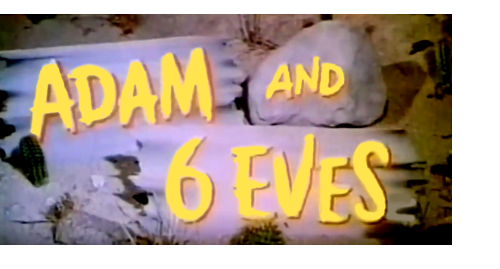
Adam and Six Eves is also reportedly a 3-D premiere — Bob Furmanek says it was never distributed in 3-D. That’s pretty amazing — even the three artsy signs that form the film’s main title are stacked in depth, to good effect. In 3-D, Adam does indeed contain shots that fulfill the old 3-D ballyhoo promise of shapely women ‘projecting’ from the film plane. Universal made that suggestion part of the publicity for their first 3-D picture It Came from Outer Space, but didn’t really follow through.
The Nudie-Cuties Collection has no extended text or authoritative featurette discussions of the films. Kino does add a pair of 3-D extras. Figure Studies in Kodachrome Stereo from 1951 is a set of twelve or so girlie nude still photos sold through the mail, complete with some kind of 3-D viewer. They are beautifully restored in bright color. One can only imagine the photographer-businessman sneaking up on his PO Box to pick up the day’s mail orders to fulfill, checking first to see if the marshalls are there, handcuffs at the ready.
The final extra is a 1953 B&W 3-D short subject called Love for Sale. It’s consists of three vignettes that don’t connect. A glamorous dancer (Bella Starr, apparently borrowing part of stripper Blaze Starr’s name) blows smoke at us from her makeup table, and struts about a bit. Part two is the first half of a strip act — she exits early. The final 3-D bit is a dance duet with a male dancer, in partial ‘Apache’ style. I’m guessing that the male dancer is Klaytan W. Kirby, the short subject’s credited director; he reportedly danced in the 1935 musical In Caliente. Kirby also directed A Virgin in Hollywood, which I remember seeing on an old Something Weird DVD of one kind or another. It’s listed as 1953, but looks much older.
Hearing impaired viewers will be at a loss — no English subtitles. I didn’t find many images from these films, and for those I did find, the quality is terrible. Just be reminded that Adam and Six Eves on Blu-ray looks splendid, like the color layout in a vintage Playboy.
The nudity in these pictures was considered smut when new yet seems innocent now. If one needs a moral excuse, just say that this is preferable to film ‘excitement’ that glamorizes violence and carnage. Conservatives and censors claimed that pictures like this inspire rapists and molesters — perhaps because they also felt guilty being curious about this kind of sex tease.
Reviewed by Glenn Erickson

The 3-D Nudie-Cuties Collection
3-D Blu-ray rates:
Movie: Bellboy Fair ++; Adam Excellent
Video: Bellboy Good; Adam Excellent
Sound: Bellboy Very Good; Adam Excellent
Supplements: Beauty in 3rd Dimension 1951 Glamour still photos; Love for Sale 1953 3-D short subject.
Deaf and Hearing-impaired Friendly? N0; Subtitles: None
Packaging: One Blu-ray with 3-D and 2-D choice of content in Keep case
Reviewed: November 9, 2019
(yXz9qQ)
Francis Coppola’s original contract for
The Bellboy and the Playgirls
And distributor 3-D projection advisories.
An exclusive, provided by Bob Furmanek
Note: Open the documents in a new window to read.
These documents will eventually join other research material at the The 3D Film Archive.
The first four items are distributor information pages about 3-D, meant to be read by theater chains and individual exhibitors to determine which version of The Bellboy and the Playgirls to order. Unless one’s projectionist staff were already familiar with 3-D, perhaps from the height of the craze eight years before, I think the average exhibitor would read these advisories and just say, ‘This is ridiculous, I’ll order it in 2-D.’ The first fact sheet even talks about ‘the recent 3-D The Mask. It really sounds as if Kino’s Blu-ray 3-D presentation of the show would be better than almost every theatrical presentation.
‘Types of 3-D Available for The Bellboy and the Playgirls‘ :
‘How to Determine if Existing Screen is Aluminized’ and more :
‘Pertinent Information for The Bellboy and the Playgirls‘ page 1 :
‘Pertinent Information for The Bellboy and the Playgirls‘ page 2 :
The last three items are Francis Coppola’s original agreements and signed contract, to co-ordinate, write and direct additional scenes for Sin Started with Eve. Note that Coppola’s letter (May 22) says he’ll write the new scenes for $250, and will direct the additional scenes for $250 more. On the same day, they pay him the first installment. But the signed contract (August 1) commits him to do the whole job for the lordly sum of $250.00.
Coppola to United Producers Organization, May 22 1961:
United Producers Organization to Coppola, May 22 1961:
United Producers Organization to Coppola, August 1 1961:
Thanks again to Bob Furmanek of The 3D Film Archive.

Visit CineSavant’s Main Column Page
Glenn Erickson answers most reader mail: cinesavant@gmail.com
Text © Copyright 2019 Glenn Erickson

